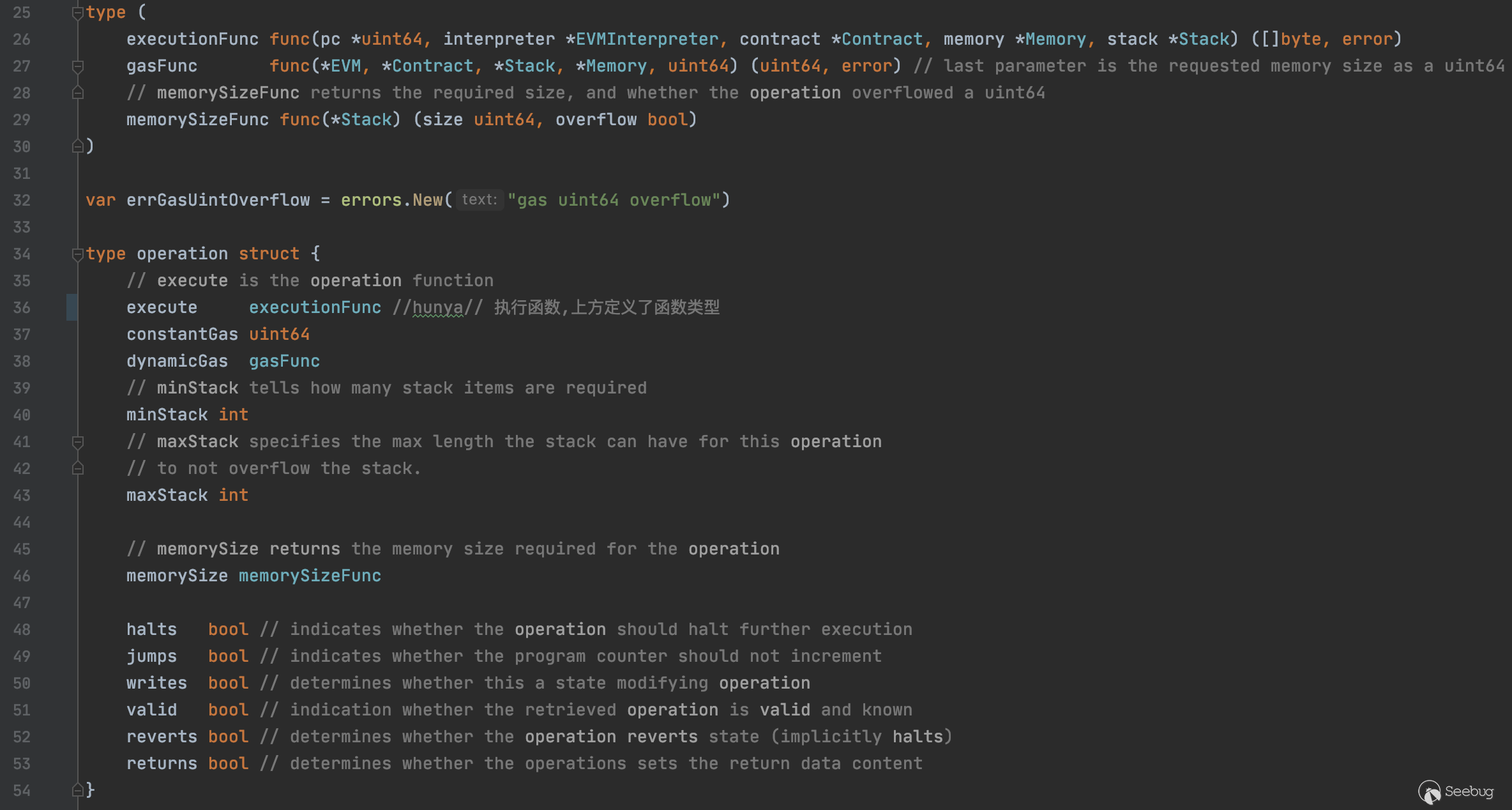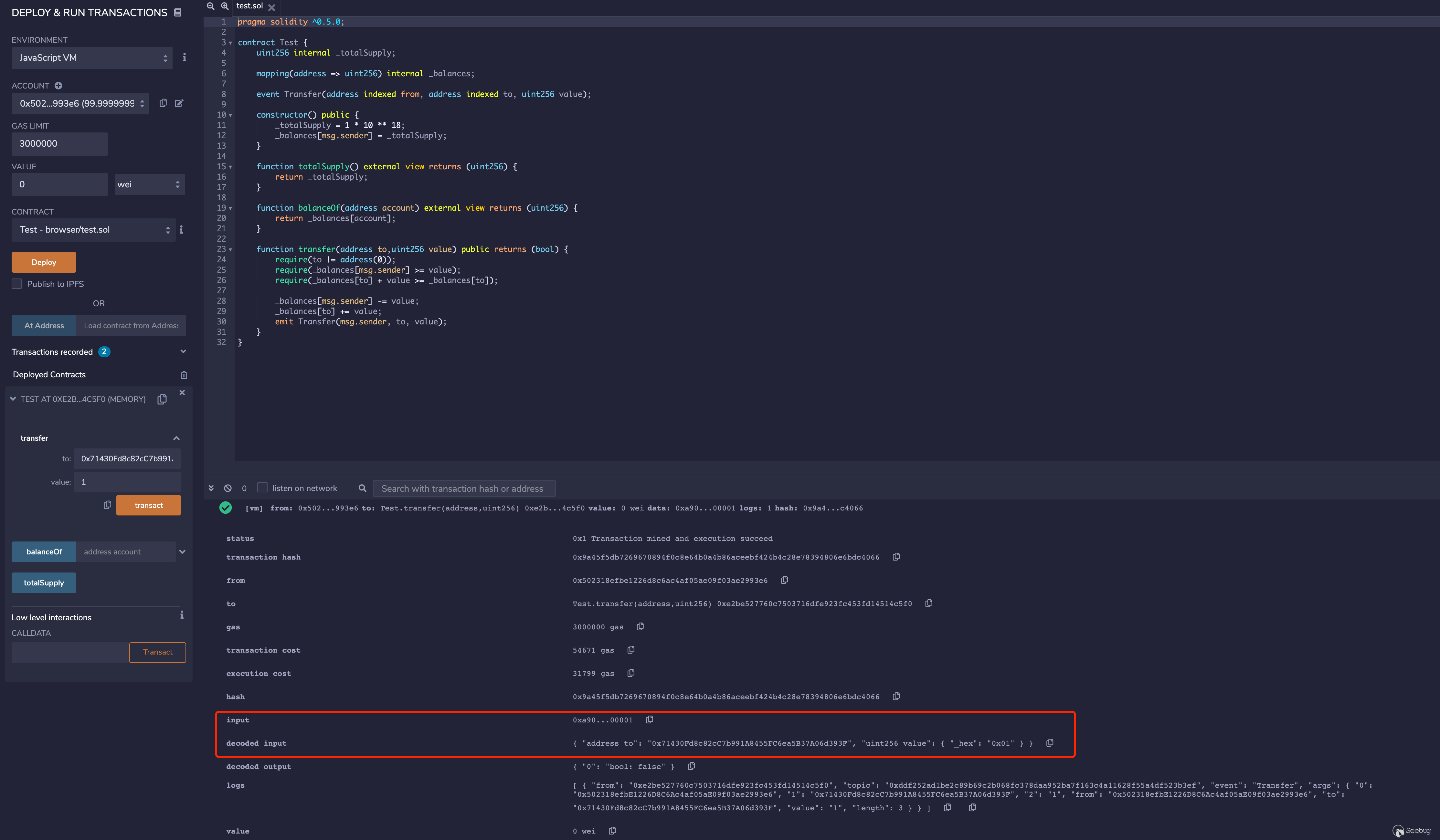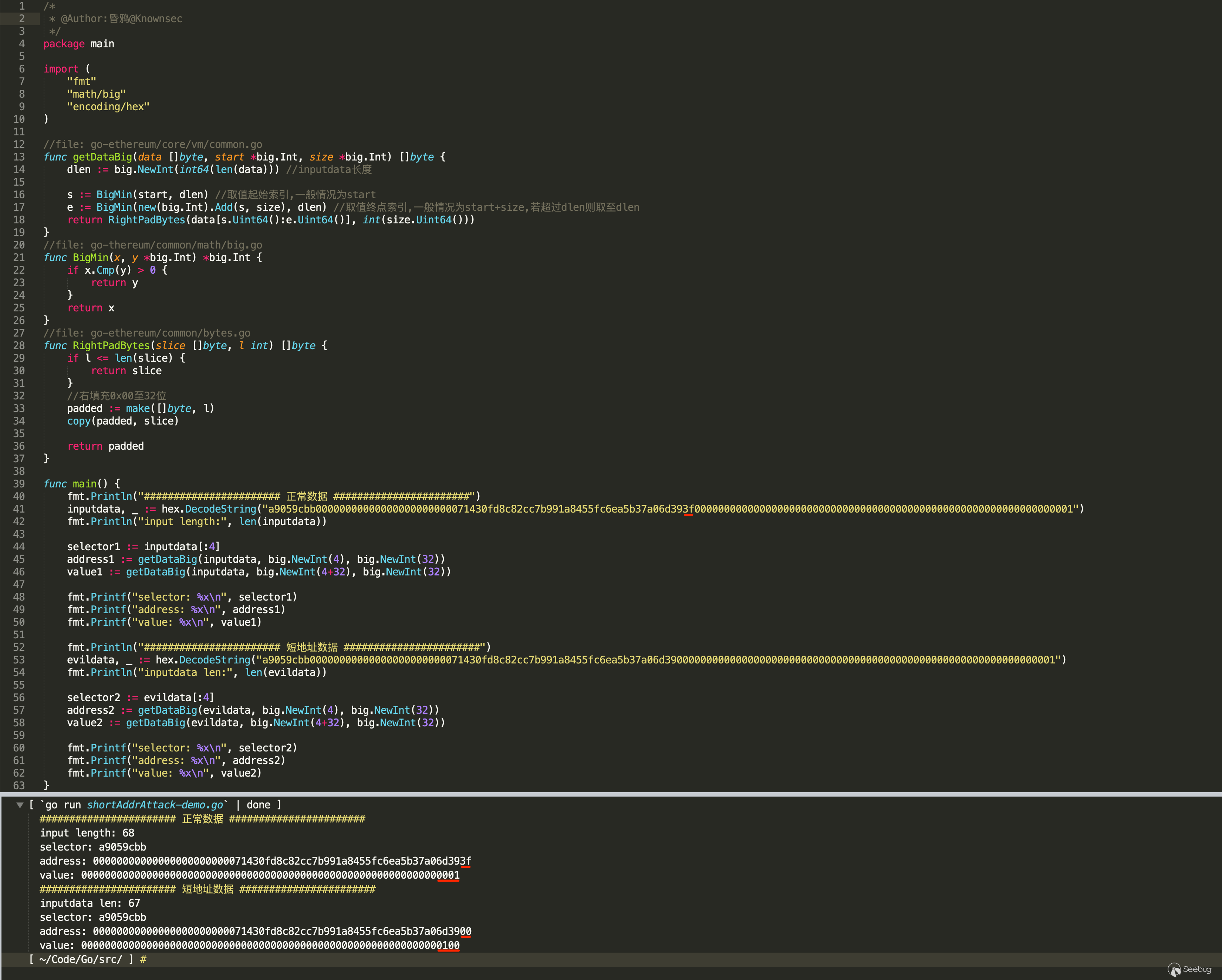以太坊安全之 EVM 与短地址攻击
作者:昏鸦@知道创宇404区块链安全研究团队
时间:2020年8月18日
前言
以太坊(Ethereum)是一个开源的有智能合约功能的公共区块链平台,通过其专用加密货币以太币(ETH)提供去中心化的以太坊虚拟机(EVM)来处理点对点合约。EVM(Ethereum Virtual Machine),以太坊虚拟机的简称,是以太坊的核心之一。智能合约的创建和执行都由EVM来完成,简单来说,EVM是一个状态执行的机器,输入是solidity编译后的二进制指令和节点的状态数据,输出是节点状态的改变。
以太坊短地址攻击,最早由Golem团队于2017年4月提出,是由于底层EVM的设计缺陷导致的漏洞。ERC20代币标准定义的转账函数如下:
function transfer(address to, uint256 value) public returns (bool success)
如果传入的to是末端缺省的短地址,EVM会将后面字节补足地址,而最后的value值不足则用0填充,导致实际转出的代币数值倍增。
本文从以太坊源码的角度分析EVM底层是如何处理执行智能合约字节码的,并简要分析短地址攻击的原理。
EVM源码分析
evm.go
EVM的源码位于go-ethereum/core/vm/目录下,在evm.go中定义了EVM结构体,并实现了EVM.Call、EVM.CallCode、EVM.DelegateCall、EVM.StaticCall四种方法来调用智能合约,EVM.Call实现了基本的合约调用的功能,后面三种方法与EVM.Call略有区别,但最终都调用run函数来解析执行智能合约
EVM.Call
|
1 2 3 4 5 6 7 8 9 10 11 12 13 14 15 16 17 18 19 20 21 22 23 24 25 26 27 28 29 30 31 32 33 34 35 36 37 38 39 40 41 42 43 44 45 46 47 48 49 50 51 52 53 54 55 56 57 58 59 60 61 62 63 64 65 66 67 68 69 70 71 72 |
// Call executes the contract associated with the addr with the given input as // parameters. It also handles any necessary value transfer required and takes // the necessary steps to create accounts and reverses the state in case of an // execution error or failed value transfer. //hunya// 基本的合约调用 func (evm *EVM) Call(caller ContractRef, addr common.Address, input []byte, gas uint64, value *big.Int) (ret []byte, leftOverGas uint64, err error) { if evm.vmConfig.NoRecursion && evm.depth > 0 { return nil, gas, nil } // Fail if we're trying to execute above the call depth limit if evm.depth > int(params.CallCreateDepth) { return nil, gas, ErrDepth } // Fail if we're trying to transfer more than the available balance if !evm.Context.CanTransfer(evm.StateDB, caller.Address(), value) { return nil, gas, ErrInsufficientBalance } var ( to = AccountRef(addr) snapshot = evm.StateDB.Snapshot() ) if !evm.StateDB.Exist(addr) { precompiles := PrecompiledContractsHomestead if evm.chainRules.IsByzantium { precompiles = PrecompiledContractsByzantium } if evm.chainRules.IsIstanbul { precompiles = PrecompiledContractsIstanbul } if precompiles[addr] == nil && evm.chainRules.IsEIP158 && value.Sign() == 0 { // Calling a non existing account, don't do anything, but ping the tracer if evm.vmConfig.Debug && evm.depth == 0 { evm.vmConfig.Tracer.CaptureStart(caller.Address(), addr, false, input, gas, value) evm.vmConfig.Tracer.CaptureEnd(ret, 0, 0, nil) } return nil, gas, nil } evm.StateDB.CreateAccount(addr) } evm.Transfer(evm.StateDB, caller.Address(), to.Address(), value) // Initialise a new contract and set the code that is to be used by the EVM. // The contract is a scoped environment for this execution context only. contract := NewContract(caller, to, value, gas) contract.SetCallCode(&addr, evm.StateDB.GetCodeHash(addr), evm.StateDB.GetCode(addr)) // Even if the account has no code, we need to continue because it might be a precompile start := time.Now() // Capture the tracer start/end events in debug mode // debug模式会捕获tracer的start/end事件 if evm.vmConfig.Debug && evm.depth == 0 { evm.vmConfig.Tracer.CaptureStart(caller.Address(), addr, false, input, gas, value) defer func() { // Lazy evaluation of the parameters evm.vmConfig.Tracer.CaptureEnd(ret, gas-contract.Gas, time.Since(start), err) }() } ret, err = run(evm, contract, input, false)//hunya// 调用run函数执行合约 // When an error was returned by the EVM or when setting the creation code // above we revert to the snapshot and consume any gas remaining. Additionally // when we're in homestead this also counts for code storage gas errors. if err != nil { evm.StateDB.RevertToSnapshot(snapshot) if err != errExecutionReverted { contract.UseGas(contract.Gas) } } return ret, contract.Gas, err } |
EVM.CallCode
|
1 2 3 4 5 6 7 8 9 10 11 12 13 14 15 16 17 18 19 20 21 22 23 24 25 26 27 28 29 30 31 32 33 34 35 36 37 38 39 40 |
// CallCode executes the contract associated with the addr with the given input // as parameters. It also handles any necessary value transfer required and takes // the necessary steps to create accounts and reverses the state in case of an // execution error or failed value transfer. // // CallCode differs from Call in the sense that it executes the given address' // code with the caller as context. //hunya// 类似solidity中的call函数,调用外部合约,执行上下文在被调用合约中 func (evm *EVM) CallCode(caller ContractRef, addr common.Address, input []byte, gas uint64, value *big.Int) (ret []byte, leftOverGas uint64, err error) { if evm.vmConfig.NoRecursion && evm.depth > 0 { return nil, gas, nil } // Fail if we're trying to execute above the call depth limit if evm.depth > int(params.CallCreateDepth) { return nil, gas, ErrDepth } // Fail if we're trying to transfer more than the available balance if !evm.CanTransfer(evm.StateDB, caller.Address(), value) { return nil, gas, ErrInsufficientBalance } var ( snapshot = evm.StateDB.Snapshot() to = AccountRef(caller.Address()) ) // Initialise a new contract and set the code that is to be used by the EVM. // The contract is a scoped environment for this execution context only. contract := NewContract(caller, to, value, gas) contract.SetCallCode(&addr, evm.StateDB.GetCodeHash(addr), evm.StateDB.GetCode(addr)) ret, err = run(evm, contract, input, false)//hunya// 调用run函数执行合约 if err != nil { evm.StateDB.RevertToSnapshot(snapshot) if err != errExecutionReverted { contract.UseGas(contract.Gas) } } return ret, contract.Gas, err } |
EVM.DelegateCall
|
1 2 3 4 5 6 7 8 9 10 11 12 13 14 15 16 17 18 19 20 21 22 23 24 25 26 27 28 29 30 31 32 33 |
// DelegateCall executes the contract associated with the addr with the given input // as parameters. It reverses the state in case of an execution error. // // DelegateCall differs from CallCode in the sense that it executes the given address' // code with the caller as context and the caller is set to the caller of the caller. //hunya// 类似solidity中的delegatecall函数,调用外部合约,执行上下文在调用合约中 func (evm *EVM) DelegateCall(caller ContractRef, addr common.Address, input []byte, gas uint64) (ret []byte, leftOverGas uint64, err error) { if evm.vmConfig.NoRecursion && evm.depth > 0 { return nil, gas, nil } // Fail if we're trying to execute above the call depth limit if evm.depth > int(params.CallCreateDepth) { return nil, gas, ErrDepth } var ( snapshot = evm.StateDB.Snapshot() to = AccountRef(caller.Address()) ) // Initialise a new contract and make initialise the delegate values contract := NewContract(caller, to, nil, gas).AsDelegate() contract.SetCallCode(&addr, evm.StateDB.GetCodeHash(addr), evm.StateDB.GetCode(addr)) ret, err = run(evm, contract, input, false)//hunya// 调用run函数执行合约 if err != nil { evm.StateDB.RevertToSnapshot(snapshot) if err != errExecutionReverted { contract.UseGas(contract.Gas) } } return ret, contract.Gas, err } |
EVM.StaticCall
|
1 2 3 4 5 6 7 8 9 10 11 12 13 14 15 16 17 18 19 20 21 22 23 24 25 26 27 28 29 30 31 32 33 34 35 36 37 38 39 40 41 |
// StaticCall executes the contract associated with the addr with the given input // as parameters while disallowing any modifications to the state during the call. // Opcodes that attempt to perform such modifications will result in exceptions // instead of performing the modifications. //hunya// 与EVM.Call类似,但不允许执行会修改永久存储的数据的指令 func (evm *EVM) StaticCall(caller ContractRef, addr common.Address, input []byte, gas uint64) (ret []byte, leftOverGas uint64, err error) { if evm.vmConfig.NoRecursion && evm.depth > 0 { return nil, gas, nil } // Fail if we're trying to execute above the call depth limit if evm.depth > int(params.CallCreateDepth) { return nil, gas, ErrDepth } var ( to = AccountRef(addr) snapshot = evm.StateDB.Snapshot() ) // Initialise a new contract and set the code that is to be used by the EVM. // The contract is a scoped environment for this execution context only. contract := NewContract(caller, to, new(big.Int), gas) contract.SetCallCode(&addr, evm.StateDB.GetCodeHash(addr), evm.StateDB.GetCode(addr)) // We do an AddBalance of zero here, just in order to trigger a touch. // This doesn't matter on Mainnet, where all empties are gone at the time of Byzantium, // but is the correct thing to do and matters on other networks, in tests, and potential // future scenarios evm.StateDB.AddBalance(addr, bigZero) // When an error was returned by the EVM or when setting the creation code // above we revert to the snapshot and consume any gas remaining. Additionally // when we're in Homestead this also counts for code storage gas errors. ret, err = run(evm, contract, input, true)//hunya// 调用run函数执行合约 if err != nil { evm.StateDB.RevertToSnapshot(snapshot) if err != errExecutionReverted { contract.UseGas(contract.Gas) } } return ret, contract.Gas, err } |
run函数前半段是判断是否是以太坊内置预编译的特殊合约,有单独的运行方式
后半段则是对于一般的合约调用解释器interpreter去执行调用

interpreter.go
解释器相关代码在interpreter.go中,interpreter是一个接口,目前仅有EVMInterpreter这一个具体实现

合约经由EVM.Call调用Interpreter.Run来到EVMInpreter.Run
EVMInterpreter的Run方法代码较长,其中处理执行合约字节码的主循环如下:

大部分代码主要是检查准备运行环境,执行合约字节码的核心代码主要是以下3行
|
1 2 3 4 5 |
op = contract.GetOp(pc) operation := in.cfg.JumpTable[op] ...... res, err = operation.execute(&pc, in, contract, mem, stack) ...... |
interpreter的主要工作实际上只是通过JumpTable查找指令,起到一个翻译解析的作用
最终的执行是通过调用operation对象的execute方法
jump_table.go
operation的定义位于jump_table.go中

jump_table.go中还定义了JumpTable和多种不同的指令集

在基本指令集中有三个处理input的指令,分别是CALLDATALOAD、CALLDATASIZE和CALLDATACOPY

jump_table.go中的代码同样只是起到解析的功能,提供了指令的查找,定义了每个指令具体的执行函数
instructions.go
instructions.go中是所有指令的具体实现,上述三个函数的具体实现如下:

这三个函数的作用分别是从input加载参数入栈、获取input大小、复制input中的参数到内存
我们重点关注opCallDataLoad函数是如何处理input中的参数入栈的
opCallDataLoad函数调用getDataBig函数,传入contract.Input、stack.pop()和big32,将结果转为big.Int入栈

getDataBig函数以stack.pop()栈顶元素作为起始索引,截取input中big32大小的数据,然后传入common.RightPadBytes处理并返回
其中涉及到的另外两个函数math.BigMin和common.RightPadBytes如下:
|
1 2 3 4 5 6 7 8 9 10 11 12 13 14 15 16 17 18 |
//file: go-thereum/common/math/big.go func BigMin(x, y *big.Int) *big.Int { if x.Cmp(y) > 0 { return y } return x } //file: go-ethereum/common/bytes.go func RightPadBytes(slice []byte, l int) []byte { if l <= len(slice) { return slice } //右填充0x00至l位 padded := make([]byte, l) copy(padded, slice) return padded } |
分析到这里,基本上已经能很明显看到问题所在了
RightPadBytes函数会将传入的字节切片右填充至l位长度,而l是被传入的big32,即32位长度
所以在短地址攻击中,调用的transfer(address to, uint256 value)函数,如果to是低位缺省的地址,由于EVM在处理时是固定截取32位长度的,所以会将value数值高位补的0算进to的末端,而在截取value时由于位数不够32位,则右填充0x00至32位,最终导致转账的value指数级增大
测试与复现
编写一个简单的合约来测试
|
1 2 3 4 5 6 7 8 9 10 11 12 13 14 15 16 17 18 19 20 21 22 23 24 25 26 27 28 29 30 31 32 |
pragma solidity ^0.5.0; contract Test { uint256 internal _totalSupply; mapping(address => uint256) internal _balances; event Transfer(address indexed from, address indexed to, uint256 value); constructor() public { _totalSupply = 1 * 10 ** 18; _balances[msg.sender] = _totalSupply; } function totalSupply() external view returns (uint256) { return _totalSupply; } function balanceOf(address account) external view returns (uint256) { return _balances[account]; } function transfer(address to,uint256 value) public returns (bool) { require(to != address(0)); require(_balances[msg.sender] >= value); require(_balances[to] + value >= _balances[to]); _balances[msg.sender] -= value; _balances[to] += value; emit Transfer(msg.sender, to, value); } } |
remix部署,调用transfer发起正常的转账

input为0xa9059cbb00000000000000000000000071430fd8c82cc7b991a8455fc6ea5b37a06d393f0000000000000000000000000000000000000000000000000000000000000001
直接尝试短地址攻击,删去转账地址的后两位,会发现并不能通过,remix会直接报错

这是因为web3.js做了校验,web3.js是用户与以太坊节点交互的媒介
源码复现
通过源码函数复现如下:

实际复现
至于如何完成实际场景的攻击,可以参考文末的链接[1],利用web3.eth.sendSignedTransaction绕过限制
实际上,web3.js做的校验仅限于显式传入转账地址的函数,如web3.eth.sendTransaction这种,像web3.eth.sendSignedTransaction、web3.eth.sendRawTransaction这种传入的参数是序列化后的数据的就校验不了,是可以完成短地址攻击的,感兴趣的可以自己尝试,这里就不多写了
PS:文中分析的go-ethereum源码版本是commit-fdff182,源码与最新版有些出入,但最新版的也未修复这种缺陷(可能官方不认为这是缺陷?),分析思路依然可以沿用
思考
以太坊底层EVM并没有修复短地址攻击的这么一个缺陷,而是直接在web3.js里对地址做的校验,目前各种合约或多或少也做了校验,所以虽然EVM底层可以复现,但实际场景中问题应该不大,但如果是开放RPC的节点可能还是会存在这种风险
另外还有一个点,按底层EVM的这种机制,易受攻击的应该不仅仅是transfer(address to, uint256 value)这个点,只是因为这个函数是ERC20代币标准,而且参数的设计恰好能导致涉及金额的短地址攻击,并且特殊的地址易构造,所以这个函数常作为短地址攻击的典型。在其他的一些非代币合约,如竞猜、游戏类的合约中,一些非转账类的事务处理函数中,如果不对类似地址这种的参数做长度校验,可能也存在类似短地址攻击的风险,也或者并不局限于地址,可能还有其他的利用方式还没挖掘出来。
参考
[1] 以太坊短地址攻击详解
[2] 以太坊源码解析:evm

本文由 Seebug Paper 发布,如需转载请注明来源。本文地址:https://paper.seebug.org/1296/
